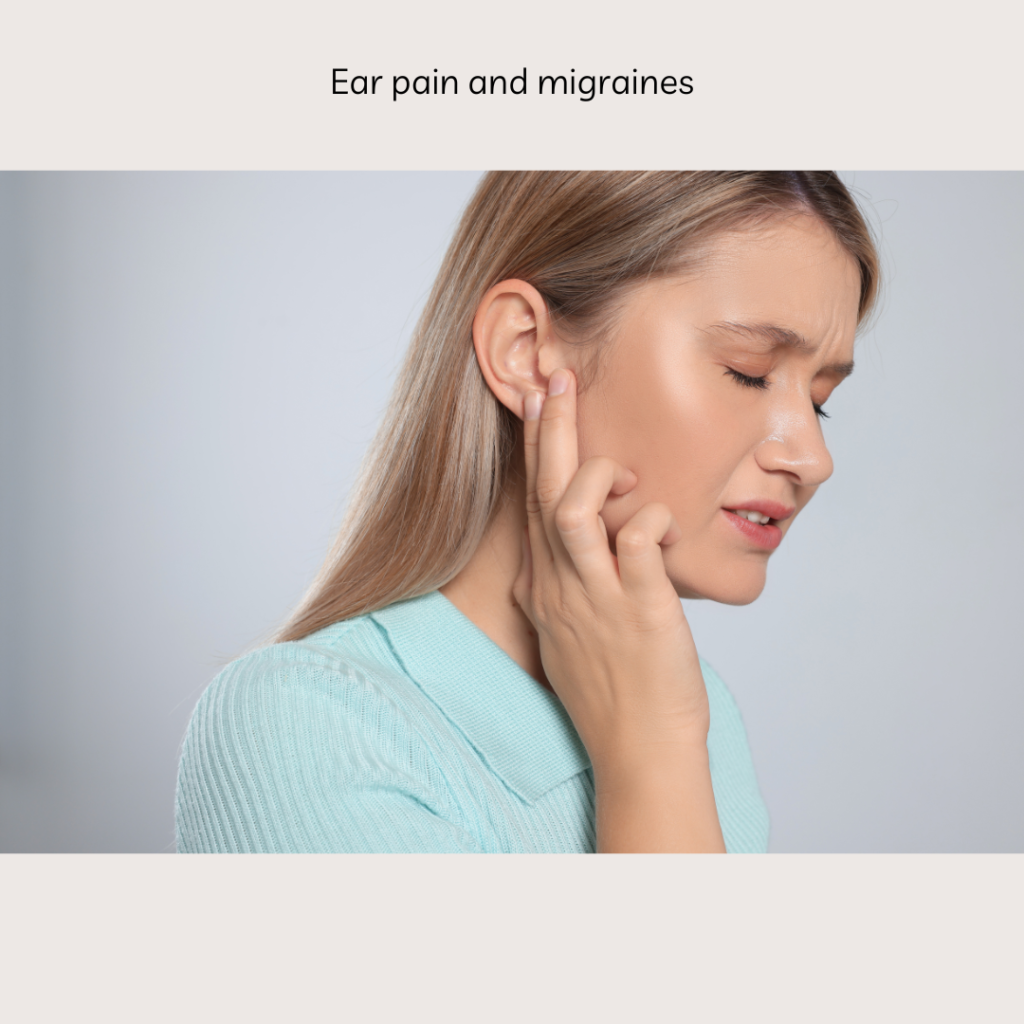Migraines are a complex neurological condition that can manifest with a variety of symptoms beyond the typical severe headache. Among these, ear pain and pressure are reported by many sufferers, yet they often remain underexplored. In this blog post, we’ll delve into why ear pain and pressure can occur with migraines, how to differentiate it from unrelated ear issues, and the connection between vestibular problems and migraine disorders.
I often have ear pain accompany my migraine headaches and have long wondered the connection between the two issues.
Why Does Ear Pain Occur with Migraines?
Ear pain and pressure during a migraine can be puzzling, but they are not uncommon. Here’s why these symptoms might accompany a migraine:
- Neurological Overlap: Migraines are primarily a neurological disorder involving the trigeminal nerve, which is responsible for sensation in the face, including areas around the ears. When a migraine strikes, this nerve can become activated or irritated, leading to pain that can be felt in the ear area.
- Autonomic Symptoms: Migraines often come with autonomic symptoms, including changes in the autonomic nervous system that can affect ear structures. For instance, the activation of the autonomic nervous system during a migraine might lead to an increase in fluid production or changes in ear pressure, contributing to a sensation of fullness or pain.
- Sinus Congestion: Although not a direct cause, sinus congestion and inflammation frequently accompany migraines. Since the sinuses are located near the ears, congestion can result in a feeling of pressure or pain in the ear region.
- Muscle Tension: Migraines can also lead to muscle tension in the head and neck. This tension might affect the muscles around the ears and jaw, causing referred pain or pressure in the ear area.
How to Differentiate Ear Pain Associated with Migraines from Unrelated Issues
Determining whether ear pain is related to a migraine or due to another issue involves assessing several symptoms and factors:
- Timing and Frequency: Ear pain that coincides with migraine episodes is more likely related to the migraine itself. If the ear pain aligns with the onset of a migraine or follows a migraine headache, it may be part of the migraine’s symptomatology.
- Pain Characteristics: Migraines often come with a throbbing or pulsating headache. If the ear pain is accompanied by these characteristics, it is more likely linked to the migraine. In contrast, ear infections or other ear-related issues usually present with a sharp or continuous ache.
- Associated Symptoms: Look for other symptoms that typically accompany migraines, such as nausea, vomiting, sensitivity to light or sound, or visual disturbances. The presence of these symptoms alongside ear pain supports the migraine connection.
- Duration: Ear pain that persists beyond the duration of a migraine or is constant without associated migraine symptoms may suggest a separate issue, such as an ear infection or temporomandibular joint (TMJ) disorder.
- Response to Migraine Treatments: If the ear pain diminishes or resolves with migraine-specific treatments (e.g., triptans or other migraine medications), it is likely connected to the migraine. Unrelated ear issues might not respond to these treatments.
The Connection Between Vestibular Issues and Migraine Disorders
Vestibular issues and migraines often intersect in a condition known as vestibular migraine. Here’s how vestibular problems can be related to migraines:
- Shared Pathophysiology: Both vestibular migraines and other types of migraines share some underlying pathophysiological mechanisms. For example, they both involve dysregulation in the brain’s processing of sensory information, which includes balance and spatial orientation.
- Vestibular Symptoms: Vestibular migraines can present with symptoms such as vertigo, dizziness, and balance problems, which may affect the ears’ perceived pressure and pain. The vestibular system, which is responsible for balance and spatial orientation, can be disrupted during a migraine, leading to these symptoms.
- Trigger Overlap: Certain triggers like hormonal changes, stress, or visual stimuli can affect both migraine and vestibular systems. This overlap can make it challenging to distinguish between vestibular symptoms of migraines and those arising from other vestibular disorders.
- Misdiagnosis and Overlap: Many people with vestibular migraines might initially be misdiagnosed with other vestibular disorders because the symptoms can be quite similar. Proper diagnosis often requires careful assessment by a healthcare provider familiar with both migraine and vestibular disorders.
What can you do about it?
When dealing with ear pain associated with migraines, managing the pain effectively can involve a combination of medications and lifestyle changes. Here’s a detailed look at potential treatments and strategies:
Medications for Ear Pain Related to Migraines
- Migraine-Specific Medications:
- Triptans: These are commonly prescribed for migraines and can help alleviate associated symptoms, including ear pain if it’s related to the migraine itself.
- Ergots: Another class of migraine medication that can be effective in managing migraine symptoms and may help with associated ear discomfort.
- Over-the-Counter Pain Relievers:
- NSAIDs (Nonsteroidal Anti-Inflammatory Drugs): Medications like ibuprofen or naproxen can help with the general pain of migraines and might indirectly ease ear pain if it’s linked to the overall headache.
- Acetaminophen: While it may not be as effective as NSAIDs for migraine pain, it can still be useful for mild pain relief.
- Antihistamines:
- Histamine Antagonists: Antihistamines like diphenhydramine or loratadine might help if the ear pain is related to sinus congestion, as they can reduce inflammation and fluid buildup. However, they are not a primary treatment for migraine-associated ear pain but can be beneficial if sinus issues are contributing to the problem.
- Decongestants:
- Pseudoephedrine: If sinus congestion is a factor, decongestants may help reduce fluid buildup and alleviate ear pressure. They should be used cautiously and not for prolonged periods due to potential side effects.
- Muscle Relaxants:
- For TMJ-Related Pain: If muscle tension in the jaw or neck is contributing to ear pain, muscle relaxants or topical treatments might provide relief.
- Anti-Nausea Medications:
- For Associated Nausea: Medications like metoclopramide or prochlorperazine can help manage nausea associated with migraines and indirectly alleviate some related discomfort.
Lifestyle Changes and Strategies
- Hydration – Stay Hydrated: Dehydration can exacerbate migraines. Drinking plenty of water helps maintain fluid balance and may prevent complications like ear pressure related to dehydration.
- Dietary Modifications – Avoid Trigger Foods: Certain foods and drinks, like caffeine, alcohol, or foods high in tyramine, can trigger migraines. Identifying and avoiding personal triggers can reduce the frequency and severity of migraines.
- Regular Sleep Patterns– Maintain a Consistent Sleep Schedule: Both too little and too much sleep can trigger migraines. Establishing a regular sleep routine helps in managing migraines and related symptoms.
- Stress Management – Practice Relaxation Techniques: Stress is a common trigger for migraines. Techniques like mindfulness, meditation, yoga, or deep breathing exercises can help reduce stress and, consequently, migraine frequency.
- Avoiding Overuse of Medications – Be Cautious with Medication Use: Overuse of pain medications can lead to rebound headaches. It’s important to follow your doctor’s guidance on medication use.
- Manage Sinus Health – Regular Nasal Irrigation: Using a saline nasal rinse can help keep the nasal passages clear and reduce sinus pressure, which may alleviate ear pressure.
- Ergonomic Adjustments – Improve Posture: Maintaining proper posture can reduce muscle tension in the neck and jaw, which might contribute to ear pain.
- Regular Exercise – Engage in Regular Physical Activity: Regular exercise can help reduce the frequency and severity of migraines and improve overall physical health.
Conclusion
Ear pain and pressure can indeed be part of the broader migraine experience, reflecting the complex interplay between neurological and autonomic functions. Differentiating this pain from other causes involves evaluating the timing, characteristics, and associated symptoms. Additionally, understanding the link between vestibular issues and migraines can provide insights into why some migraine sufferers experience balance-related symptoms.
If you experience ear pain alongside migraines or vestibular symptoms, it’s essential to consult a healthcare provider for a comprehensive evaluation and tailored treatment plan. Proper diagnosis and management can help alleviate symptoms and improve overall quality of life for those affected by these intertwined conditions.








